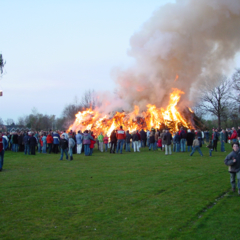The midwinter horn is made in a traditional way out of a naturally grown branch or trunk. It consists of two hollowed parts of one trunk, of about 4 to 5 feet long, which are sealed airtight lengthwise, the width running from less than wrist thickness to so wide that a fist fits into the beker (chalice), preferably with a curvature, as formed by the growth of the trunk. The happe, a small, round and hollow, conical pipe, forms the loose mouthpiece of the midwinter horn.
Building a midwinter horn is a 7 phase operation: cutting or sawing wood; drying the trunk or immediate processing of the fresh trunk; sawing the trunk into two and drilling the (hap)hole; hollowing out each half to a thickness of about 3 inches with a wooden hammer or a beater and a firmer gouge; finishing the inside further until the wall of both halves is equally thick and the inside nice and smooth; when the wood is dry enough, gluing both halves together with waterproof wood glue and drying in one day; making the happe of elder wood.
At the end of the process fresh wood is still wet. When they are not being worked on, the horn halves are clamped with properly tightened hose rings. The horn still has to dry well (a week or more). The clamps are also used while working with dry wood (to prevent warping of the halves).


